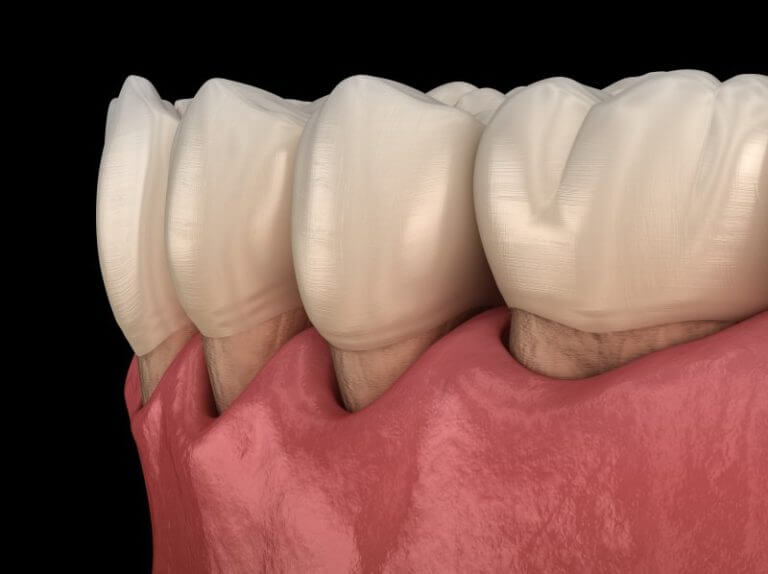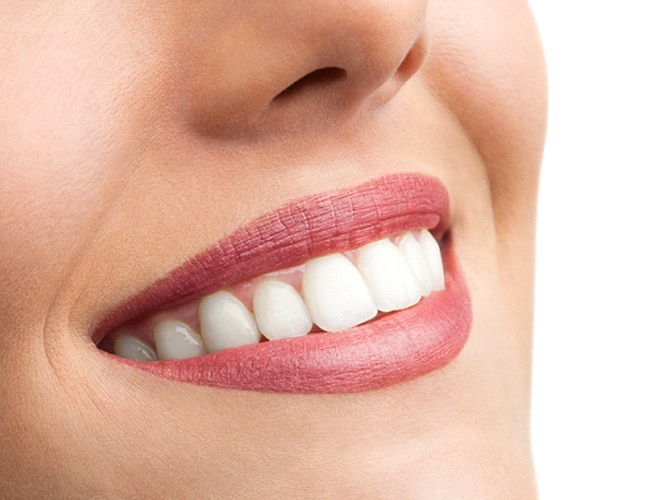What is a gum graft?
A gum graft is a procedure that's done to improve the quality of gum tissue in a particular area around the natural teeth. In some procedures, if too much of the root is exposed, there's an opportunity to cover up part or all of the root as well.
What is the difference between a connective tissue graft and a pre-gingival graft?
There are many different types of gum grafts available, each indicated for certain situations. The most common types of gum grafts involve taking gum tissue from the roof of the mouth. The two common types that use this material are the connective tissue graft and the free gingival graft. Substitute materials are also available for different procedures.
Can you tell me more about connective tissue grafts?
A connective tissue graft is a procedure where tissue is taken from the roof of the mouth to thicken and improve the quality of the tissue at the recipient site, where the tooth has too much root exposed. The goal of this procedure is to cover the root of the tooth and to thicken the quality of tissue in the area.
Can you tell me more about free gingival grafts?
A free gingival graft is a procedure where gum tissue is taken from the roof of the mouth. However, due to the location and the anatomy of the area, it's not ideal for attempting to gain root coverage. The goal of a free gingival graft is specifically to thicken the quality of gum tissue to prevent tooth loss.
What conditions would cause a dentist to recommend gum grafting?
Gum grafting is recommended when there's gum recession or the gums have pulled back off of the side of the tooth. This means both the gum and the bone tissue on the front of the tooth are now gone. If there's not great quality gum tissue in the area, these conditions would be used to make a diagnosis for the need for a gum graft.
What is the advantage of saving a tooth with gum grafting?
The goal is always to save a natural tooth. When gum recession and its associated conditions continue to worsen, the likelihood of losing a tooth increases. Performing the gum grafting procedure stops the gum recession to prevent tooth loss. If part of the root can also be covered for a cosmetic result, that's ideal. But the primary goal of gum grafting is to thicken the quality of tissue to save a natural tooth.
What are the steps associated with connective tissue grafts?
There are a number of steps involved in the clinical procedure of connective tissue grafting. First, the patient is made comfortable and the area is prepared. Then, gum tissue is taken from the roof of the mouth. The new tissue is then placed into the recipient site and everything is closed into place to get an ideal result.
What are the steps involved in free gingival grafts?
A free gingival graft involves preparing the recipient site, removing tissue from the roof of the mouth, and placing the gum tissue down below where the actual recession is. This allows the new gum tissue to sit below and act as a protective band to prevent any future gum recession.
When choosing a gum graft technique, what are the options I have and what are the pros and cons of each?
There are many options available for gum grafting, and the correct one depends on the specific case. We can use the patient's own tissue (palatable tissue) or alternative materials. Using the patient's own tissue often results in an ideal fit, but alternative materials can result in less postoperative discomfort. It's best to discuss with a doctor to know which option is right for you.
How long does it take to recover from a gum grafting using palatable tissue?
Most significant postoperative pain from a gum graft using palatable tissue is within the first week. We provide a stent to cover the graft from the roof of the mouth to simplify the post-operative experience. The recovery could be more uncomfortable if more teeth are involved in the procedure.
How long does it take to recover from a gum grafting procedure using non-palatable tissue?
When a patient uses non-palatable tissue, post-operative recovery is usually very easy, with not much significant pain involved. However, any sutures in place may need to stay there for a longer period of time as the tissue takes longer to integrate into the area.
How long do the results last from gum grafting?
Gum grafting is meant to be a one-time procedure. However, if an area needs to be grafted in the future, we can always address those needs at indicated sites if necessary.
What are the financing options involved with gum grafting?
Many financing options are available for gum grafting. We can look into dental insurance to see if there's any associated benefit. Some plans may cover a portion of the procedure, but there will almost always be an out-of-pocket expense. If needed, there are multiple vendors we can work with to spread payments out over a period of time.
How can I schedule an appointment to talk to a dentist about gum grafting?
When you're ready to discuss gum grafting further, please call us at (850) 692-9200 to schedule an exam with the doctor. We can see you as a patient with or without a referral. If you have questions, we're always happy to see you to determine if gum grafting is an appropriate procedure for you.
Repair Your Receding Gums
When you smile at yourself in the mirror, do you notice that you look a little “long in the tooth”? Are the teeth that look longer than they used to extra sensitive to hot and cold temperatures? You may be suffering from a degree of gum recession. Unfortunately, your gums will not grow back on their own. However, it may be possible to repair them with gum grafting. This procedure could be the ideal way to protect your tooth roots and improve your smile’s aesthetics.
Why Choose Periodontics & Implant Dentistry of Tallahassee for Gum Grafting?
- Board-Certified Periodontist
- Gentle, Comfortable Treatment
- Natural-Looking Results

Why Does Gum Recession Occur?
Periodontal disease, otherwise known as gum disease, is one of the most common causes of gum recession. In its earliest stages, gum disease simply causes the gums to become red and swollen. However, as it progresses, the bacteria that is responsible for gum disease can attack the underlying bone tissue. As the bone shrinks, the gums recede, and bacteria-filled pockets form between the teeth and the gums. If you have gum disease, your periodontist in Tallahassee will treat it before your gum grafting procedure.
Of course, there are other possible reasons for gum recession. A few examples include:
- Bruxism (habitual teeth grinding and clenching)
- Overaggressive brushing and flossing habits
- Lip and tongue piercings that irritate the delicate gum tissue
- A misaligned bite
- Genetics

How Gum Grafting Works
Gum grafting is a procedure wherein Dr. Rasmussen attaches additional tissue to your gums where they have receded. During the healing process, the body integrates the grafted tissue, allowing it to function as a normal part of your mouth. The tissue that Dr. Rasmussen grafts onto your gums may come from the roof of your mouth or another nearby location. It is also possible to use donated tissue from another human.
There are a few different types of gum grafts, including:
- A free gingival graft, which uses tissue from the palate to thicken the gums
- A subepithelial connective tissue graft, which covers exposed tooth roots
- An acellular dermal matrix allograft, which uses donated tissue to add to a patient’s gums
Prior to your gum graft procedure, Dr. Rasmussen will answer your questions about the specific type of surgery that he believes is best for you. He will also give you detailed instructions to facilitate a smooth recovery following your treatment.
Do you believe that you could benefit from a gum graft? Contact our team today to schedule your personalized consultation!
Gum Grafting FAQs
Gum grafting is a common procedure used to promote a healthy, beautiful smile; however, it’s normal to feel a little apprehensive before moving forward. Your periodontist will explain everything during your gum grafting consultation to calm your nerves. While you wait for your appointment, here are the answers to the most frequently asked questions.
Does gum grafting hurt?
You don’t have to worry about a painful day in the dental chair. Gum grafting is an in-office procedure performed using a local anesthetic. You won’t feel anything during the procedure; however, your gums may be a little tender for a few days. It is best to avoid any hard, crunchy, spicy, or acidic foods while your tissue heals. You can manage any discomfort using OTC pain relievers. You may be prescribed a mouth rinse or antibiotics. Any mild swelling or tenderness will subside within a week.
How long does it take to heal?
The gums tend to heal quickly, so you don’t have to worry about a lengthy recovery. Everyone heals differently, but most patients are fully recovered in 1-2 weeks. However, several factors affect how long it will take, like following your aftercare instructions. You can avoid any delays in your recovery by keeping your mouth clean, following your post-op instructions, and watching what you eat. You’ll want to avoid smoking and alcohol because they can affect the body’s ability to heal and fight infections.
How much does gum grafting cost?
There isn’t a flat fee for gum grafting because every situation is unique. After examining your mouth to create a treatment plan, we will provide you with a personalized estimate and review your payment options. Various factors will affect the amount you’ll pay, like the number of teeth being treated, medications, and dental insurance. Our office accepts a variety of payment methods to keep your care affordable, including special offers and third-party financing. We will help you find the solutions you need to repair your smile without draining your bank account.
Can I use my dental insurance to pay for gum grafting?
The answer depends on the reason for the procedure. Generally, dental insurance doesn’t cover elective procedures, but gum grafting is often used for medically necessary purposes. As a result, your dental insurance can cover a portion of the cost to lower the amount you pay. Although every situation differs, some medical insurances can also be used when the procedure is deemed a medical necessity. Often, gum grafting is mostly or fully covered, so you don’t have to deal with a large bill.
How long does a gum graft last?
A gum graft can last forever in most cases. The underlying cause of gum recession must be resolved before the procedure, like treating an infection. The duration of your results also depends on your follow-up care and maintenance. You can ensure your graft lasts for a lifetime by brushing, flossing, and using a daily mouthrinse. Don’t forget to visit your dentist every 6 months for a cleaning and checkup.

